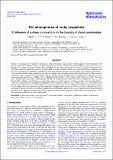Files in this item
The atmospheres of rocky exoplanets : II. Influence of surface composition on the diversity of cloud condensates
Item metadata
| dc.contributor.author | Herbort, O. | |
| dc.contributor.author | Woitke, P. | |
| dc.contributor.author | Helling, C. | |
| dc.contributor.author | Zerkle, A.L. | |
| dc.date.accessioned | 2022-03-14T16:30:04Z | |
| dc.date.available | 2022-03-14T16:30:04Z | |
| dc.date.issued | 2022-02 | |
| dc.identifier | 278226805 | |
| dc.identifier | 8c6eb254-54ac-4d09-ab1d-8250e7a5ea10 | |
| dc.identifier | 85125501319 | |
| dc.identifier | 000758370700001 | |
| dc.identifier.citation | Herbort , O , Woitke , P , Helling , C & Zerkle , A L 2022 , ' The atmospheres of rocky exoplanets : II. Influence of surface composition on the diversity of cloud condensates ' , Astronomy and Astrophysics , vol. 658 , A180 . https://doi.org/10.1051/0004-6361/202141636 | en |
| dc.identifier.issn | 0004-6361 | |
| dc.identifier.other | RIS: urn:B828FDB0C6C6B3D142C6E6040468FD90 | |
| dc.identifier.other | ORCID: /0000-0003-2324-1619/work/109766676 | |
| dc.identifier.other | ORCID: /0000-0002-1807-4441/work/109766823 | |
| dc.identifier.uri | https://hdl.handle.net/10023/25041 | |
| dc.description | O.H. acknowledges the PhD stipend form the University of St Andrews’ Centre for Exoplanet Science. P.W. and Ch.H. acknowledge funding from the European Union H2020-MSCA-ITN-2019 under Grant Agreement no. 860470 (CHAMELEON). | en |
| dc.description.abstract | Clouds are an integral part of planetary atmospheres, with most planets hosting clouds. Understanding not only the formation, but also the composition of clouds, is crucial to understand future observations. As observations of the planet's surface will remain very difficult, it is essential to link the observable high atmosphere gas and cloud composition to the surface conditions. We present a fast and simple chemical equilibrium model for the troposphere of rocky exoplanets, which is in chemical and phase equilibrium with the crust. The hydrostatic equilibrium atmosphere is built from bottom to top. In each atmospheric layer, chemical equilibrium is solved and all thermally stable condensates are removed, depleting the atmosphere above in the effected elements. These removed condensates build an upper limit for cloud formation and can be separated into high and low temperature condensates. The most important cloud condensates for 1000K >∼ Tgas >∼ 400K are KCl[s], NaCl[s], FeS[s], FeS2[s], FeO[s], Fe2O3[s], and Fe3O4[s]. For Tgas ∼< 400K H2O[l,s], C[s], NH3[s], NH4Cl[s], and NH4SH[s] are thermally stable, while for even lower temperatures of Tgas ≤ 150K CO2[s], CH4[s], NH3[s], and H2S[s] become stable. The inclusion of clouds with trace abundances results in the thermal stability of a total of 72 condensates for atmospheres with different surface conditions (300K ≤ Tsurf ≤ 1000K and psurf = 1 bar; 100 bar). The different cloud condensates are not independent of each other, but follow sequences of condensation, which are robust against changes in crust composition, surface pressure, and surface temperature. Independent of the existence of water as a crust condensate, H2O[l,s] is a thermally stable cloud condensate for all investigated elemental abundances. However, the water cloud base depends on the hydration level of the crust. Therefore, the detection of water condensates alone does not necessarily imply stable water on the surface, even if the temperature could allow for water condensation. | |
| dc.format.extent | 24 | |
| dc.format.extent | 16268574 | |
| dc.language.iso | eng | |
| dc.relation.ispartof | Astronomy and Astrophysics | en |
| dc.subject | Planets and satellites: Atmospheres | en |
| dc.subject | Planets and satellites: composition | en |
| dc.subject | Planets and satellites: Surfaces | en |
| dc.subject | Planets and satellites: terrestrial planets | en |
| dc.subject | Astrochemistry | en |
| dc.subject | QB Astronomy | en |
| dc.subject | QC Physics | en |
| dc.subject | QD Chemistry | en |
| dc.subject | T-NDAS | en |
| dc.subject.lcc | QB | en |
| dc.subject.lcc | QC | en |
| dc.subject.lcc | QD | en |
| dc.title | The atmospheres of rocky exoplanets : II. Influence of surface composition on the diversity of cloud condensates | en |
| dc.type | Journal article | en |
| dc.contributor.sponsor | European Commission | en |
| dc.contributor.institution | University of St Andrews. School of Physics and Astronomy | en |
| dc.contributor.institution | University of St Andrews. St Andrews Centre for Exoplanet Science | en |
| dc.contributor.institution | University of St Andrews. School of Earth & Environmental Sciences | en |
| dc.contributor.institution | University of St Andrews. St Andrews Isotope Geochemistry | en |
| dc.identifier.doi | https://doi.org/10.1051/0004-6361/202141636 | |
| dc.description.status | Peer reviewed | en |
| dc.identifier.url | https://arxiv.org/abs/2111.14144 | en |
| dc.identifier.grantnumber | 860470 | en |
This item appears in the following Collection(s)
Items in the St Andrews Research Repository are protected by copyright, with all rights reserved, unless otherwise indicated.

